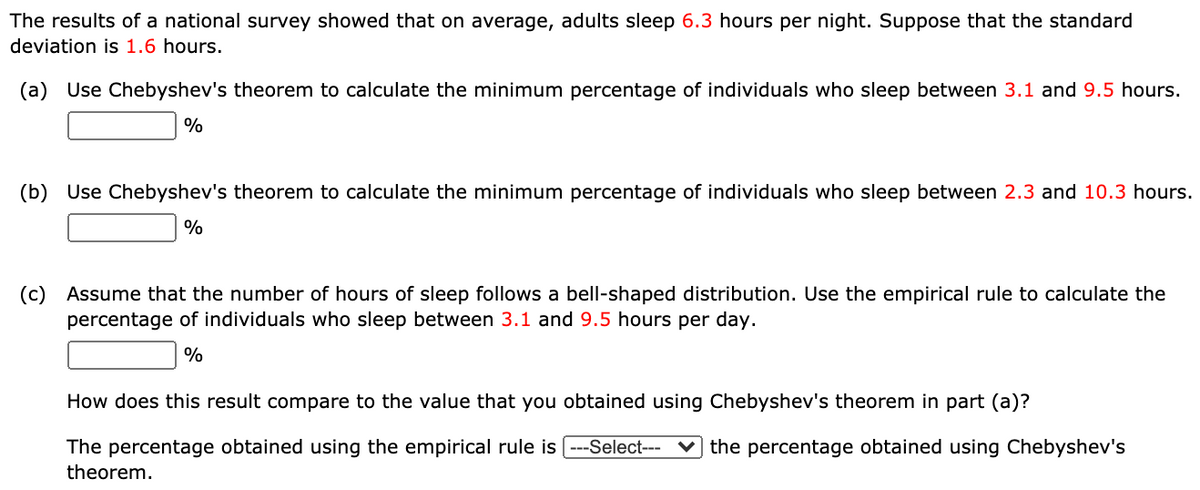The results of a national survey showed that on average, adults sleep 6.3 hours per night. Suppose that the standard deviation is 1.6 hours. (a) Use Chebyshev's theorem to calculate the minimum percentage of individuals who sleep between 3.1 and 9.5 hours. % (b) Use Chebyshev's theorem to calculate the minimum percentage of individuals who sleep between 2.3 and 10.3 hours % (c) Assume that the number of hours of sleep follows a bell-shaped distribution. Use the empirical rule to calculate the percentage of individuals who sleep between 3.1 and 9.5 hours per day. % How does this result compare to the value that you obtained using Chebyshev's theorem in part (a)? The percentage obtained using the empirical rule is --Select-- the percentage obtained using Chebyshev's
The results of a national survey showed that on average, adults sleep 6.3 hours per night. Suppose that the standard deviation is 1.6 hours. (a) Use Chebyshev's theorem to calculate the minimum percentage of individuals who sleep between 3.1 and 9.5 hours. % (b) Use Chebyshev's theorem to calculate the minimum percentage of individuals who sleep between 2.3 and 10.3 hours % (c) Assume that the number of hours of sleep follows a bell-shaped distribution. Use the empirical rule to calculate the percentage of individuals who sleep between 3.1 and 9.5 hours per day. % How does this result compare to the value that you obtained using Chebyshev's theorem in part (a)? The percentage obtained using the empirical rule is --Select-- the percentage obtained using Chebyshev's
Linear Algebra: A Modern Introduction
4th Edition
ISBN:9781285463247
Author:David Poole
Publisher:David Poole
Chapter4: Eigenvalues And Eigenvectors
Section4.6: Applications And The Perron-frobenius Theorem
Problem 25EQ
Related questions
Concept explainers
Contingency Table
A contingency table can be defined as the visual representation of the relationship between two or more categorical variables that can be evaluated and registered. It is a categorical version of the scatterplot, which is used to investigate the linear relationship between two variables. A contingency table is indeed a type of frequency distribution table that displays two variables at the same time.
Binomial Distribution
Binomial is an algebraic expression of the sum or the difference of two terms. Before knowing about binomial distribution, we must know about the binomial theorem.
Topic Video
Question

Transcribed Image Text:The results of a national survey showed that on average, adults sleep 6.3 hours per night. Suppose that the standard
deviation is 1.6 hours.
(a) Use Chebyshev's theorem to calculate the minimum percentage of individuals who sleep between 3.1 and 9.5 hours.
%
(b) Use Chebyshev's theorem to calculate the minimum percentage of individuals who sleep between 2.3 and 10.3 hours.
%
(c) Assume that the number of hours of sleep follows a bell-shaped distribution. Use the empirical rule to calculate the
percentage of individuals who sleep between 3.1 and 9.5 hours per day.
%
How does this result compare to the value that you obtained using Chebyshev's theorem in part (a)?
The percentage obtained using the empirical rule is ---Select--- ♥ the percentage obtained using Chebyshev's
theorem.
Expert Solution
This question has been solved!
Explore an expertly crafted, step-by-step solution for a thorough understanding of key concepts.
This is a popular solution!
Trending now
This is a popular solution!
Step by step
Solved in 3 steps with 1 images

Knowledge Booster
Learn more about
Need a deep-dive on the concept behind this application? Look no further. Learn more about this topic, statistics and related others by exploring similar questions and additional content below.Recommended textbooks for you

Linear Algebra: A Modern Introduction
Algebra
ISBN:
9781285463247
Author:
David Poole
Publisher:
Cengage Learning

Linear Algebra: A Modern Introduction
Algebra
ISBN:
9781285463247
Author:
David Poole
Publisher:
Cengage Learning